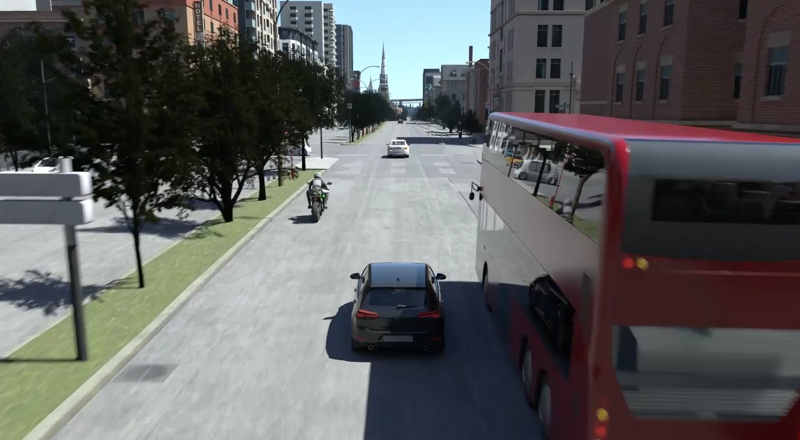Sensor Realistic
The safety of an autonomous vehicle (AV) or advanced driver assistance system (ADAS) depends entirely on the performance of its perception sensors.
Scroll to explore
Building a truly realistic and accurate AV/ADAS simulation, with repeatability and predictability equally depends on the extreme precision of multiple interconnected sensor models.
The advanced physics-based sensor models that are integrated within the AV Sandbox simulation platform generate identical output data feed as real devices. This allows your AV/ADAS control system to be fully immersed into the simulation environment, making it considerably easier to test and validate the performance of the complete AV system, including the perception algorithms that process sensor data to make real-time driving decisions.
Sensor choice for AV simulation
We offer a wide and growing range of sensor models for use with AVSandbox. These models include: radar, LIDAR, ultrasound, GPS and various camera options.
In each case, the sensor models produce exactly the same output data as real-world devices and can be seamlessly integrated, making it easy to create complex composite simulations including:
- Physics based models: geometry, material properties, frequency and polarization influence sensor responses, such as wave propagation, reflection and scattering
- Dynamic sensor capture, with rotation of sensor with time, beam scanning, etc.
- An extensive library of models that replicate commercially available sensors, including:
- LiDAR sensors from Ibeo, Ouster & Velodyne
- Radar sensors from Ainstein, Delphi & Continental
- OXTS GPS and IMU
- Others available on request
AV/ADAS sensor flexibility & capability
Advanced sensor simulation allows you to subject your AV or ADAS system to rigorous, deterministic, and challenging tests quickly and efficiently, and at far lower cost, than physically driving a vehicle under different test scenarios on public roads or test tracks.
You can therefore identify and combat issues concerning potential vehicle safety or performance early in the development process, before significant investment is made in vehicle hardware and software.

Just as importantly, sensor simulation makes it possible to test AV or ADAS programmes under a wide range of conditions and scenarios, including situations that might otherwise be difficult or impossible to recreate in the real world. For example, a simulation might be used to test how an AV would respond to an expected action by a pedestrian, or to evaluate the ability of the vehicle to navigate a winding mountain road in foggy conditions, or with challenging light conditions/dirt on a camera lens. These, and many other variables are achievable on our AV Sandbox platform.
Simulation data & sensor fusion
AVSandbox provides exceptional power and flexibility.
The system allows you to position sensors anywhere on the vehicle, while features such as panoptic segmentation give you complete control over object segmentation, with 2D and 3D bounding boxes, velocity profiles and depth mapping.


AVSandbox also allows you to simulate data from multiple sensors and to mimic the process of sensor fusion, to create a hyper-realistic environmental model. Simulated data from each sensor model can be combined in different ways, based on either actor or signal level fusion.
In the actor level fusion model, first detection of different actors, such as pedestrians or other vehicles, provides the simulation data, while in the signal level fusion model the raw sensor data is simulated and captured before the various actors are detected.
The choice is yours.
Discover more
The AVSandbox Knowledge Hub
Discover more about what makes AVSandbox unique. Explore our AVSandbox knowledge hub and find out about the issues, challenges and exciting developments that are behind the growth of the market for autonomous vehicles and advanced driver assistance systems.
Ultra photorealism in AVSandbox
Thanks to the hard work of rFpro, ultrarealistic light rendering is now available in the AVSandbox toolkit. This is ...
Tackling High Development Costs: How AVSandbox Can Accelerate Your Autonomous Vehicle Deployment
Reducing costs of autonomous vehicle development without compromising AV Safety The development and successful deployment of autonomous vehicles is ...
Determinist Traffic Simulation
Introduction In my previous blog deterministic scenario simulation, I detailed why we define our simulator deterministic and what is ...


